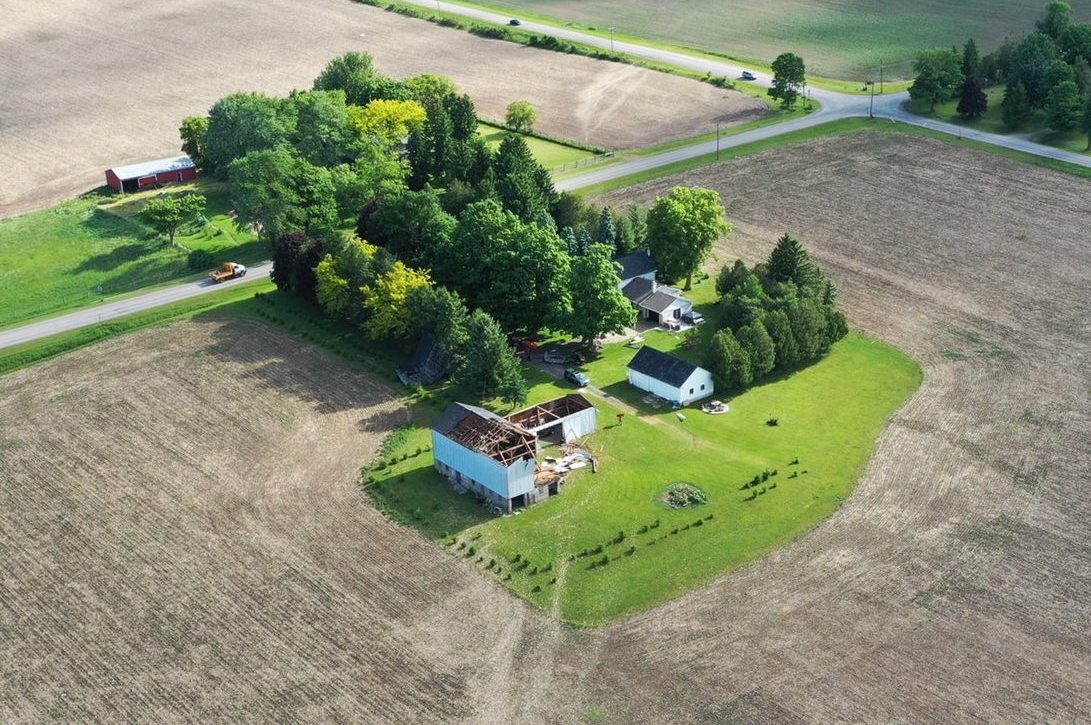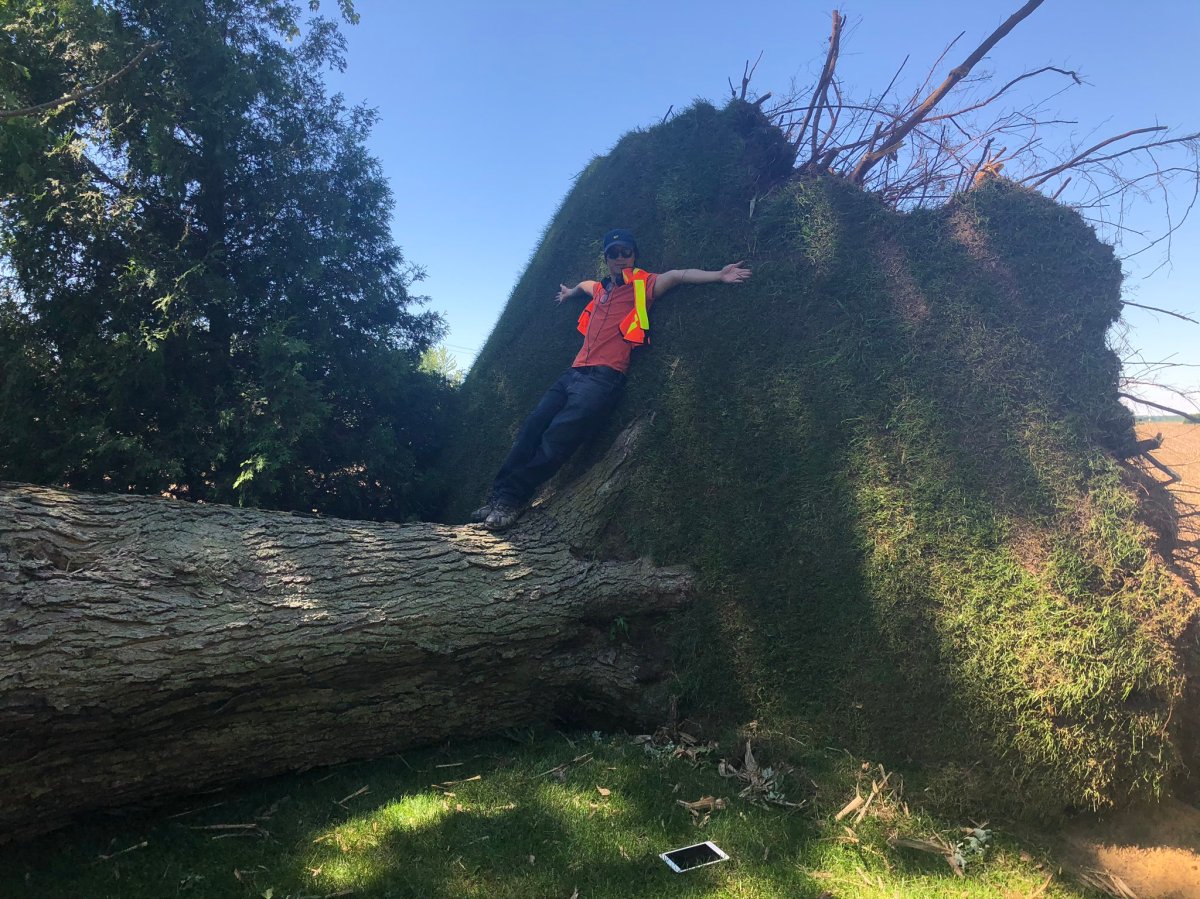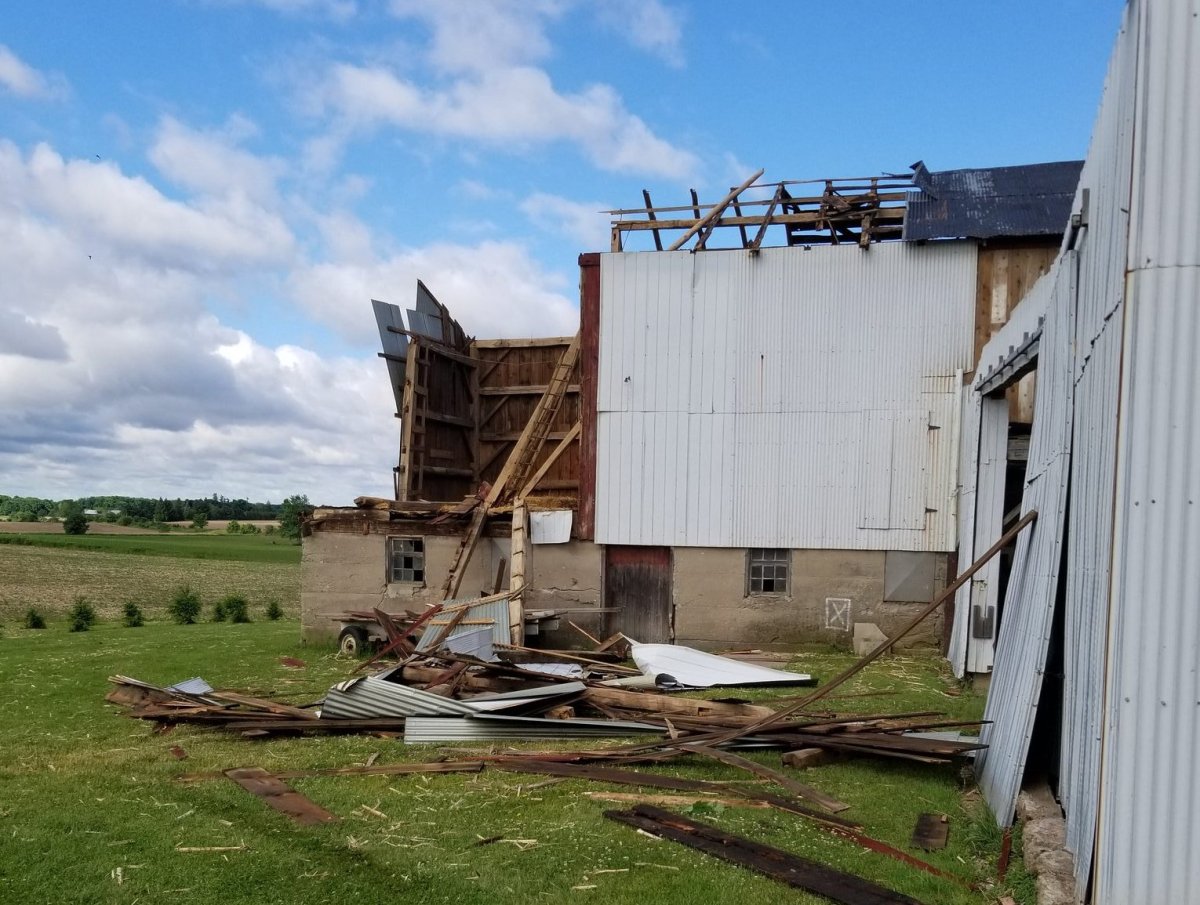Local researchers have confirmed that the severe thunderstorms that uprooted trees, snapped branches and cut power across southwestern Ontario Wednesday night also spawned two tornadoes near London, Ont.

Western University’s Northern Tornadoes Project (NTP) confirmed Friday that damage surveys conducted over the last two days had determined that Glencoe, Ont. and Belmont, Ont., saw preliminary EF0 and EF1 tornadoes touch down, respectively, during Wednesday’s storm.
According to Environment Canada, reports of a tornado near Glencoe came in first around 7:50 p.m., with reports of a tornado near Belmont to the east arriving about 40 minutes later.
The two tornadoes are the first to be reported in the province this year, said Dr. David Sills, NTP’s executive director.
“To have them kind of occurring almost mid-June is quite late in the season,” he said.
While the London-area tornadoes are on the weaker side of the Enhanced Fujita scale — the most severe tornadoes are rated EF5 — the survey team still found plenty of damage to trees and farm buildings along the tornadoes’ paths.
Near Glencoe, surveyors found a large, toppled-over maple tree, and damage to nearby farm buildings, including a destroyed, old barn.
Sills said the EF0 tornado touched down near Newbury Station and ended just east of Strathburn — a track length of about 17 kilometres.
“The maximum width of the path is about 300 metres, and we estimate the maximum wind speed is about 130 km/h, which is right at the top end of EF0.”
Most damage, Sills says, was inflicted to fields and trees, but there were some structures that did get hit.
“There were a few properties where there were workshops and sheds and that kind of thing turned over or the roof removed, and there was an old barn that was collapsed as well,” he said.
Kelly Janssen was among the residents whose properties were damaged.
The Glencoe-area resident recalled to 980 CFPL on Thursday how quickly the sky west of her home turned dark as the storm approached.
“We have a large row of tall evergreens, and I guess the ‘aha’ moment for me was, in a second, those were laying flat on the ground,” she told 980 CFPL’s Mike Stubbs.
Janssen said as she and her daughter ran into the basement, her husband and son, along with a family friend and his son, were in the shop across the laneway.
“I think my husband and our friend and the two boys were thinking, stay put, as you typically do,” she said.
“But my son told me this morning ‘when Dad saw daylight coming through the roof, we then decided to move.’… The roof ripped off when they were in there.”

The four managed to get to the house and everyone huddled in the basement, she said.
“They’re not joking when they say it happens in a second and it’s done, and then it was just kind of looking around at the shrapnel.”
No one was hurt she said, but debris from the building could be found strewn across the property and in the crops.
Since the storm, Janssen says friends and neighbours have stepped up to help, with some facing their own problems.
“My best friend is dealing with a horse issue, they have buildings down. It’s different for everybody. It had a definite path,” she said.
“It took the roof of our building and then it kind of went between a silo and a huge tree and just continued on toward Belmont.”
About a half hour later and some 50 kilometres away, a separate tornado would make its presence felt east of Belmont.
The EF1 tornado, reported around 8:30 p.m., tracked 18 kilometres, had a maximum width of 250 metres — on the narrower side, according to NTP — and damaged barns, sheds, and a number of trees.
“We estimate that the maximum wind speed from the tornado was about 150 km/h,” Sills said.
Some of the damage included a farm building near Shain Road and Harrietsville Drive that had its roof partially removed and relocated onto nearby railroad tracks.
A property a kilometre northeast, meanwhile, had the roofs of at least two farm buildings pulled off.
“This was a weak tornado, but you can see even a weak tornado can cause quite a bit of damage.”

The Belmont-area tornado was captured on camera by Global News’ chief meteorologist, Anthony Farnell, who was in the area chasing the storm.
“I happened to be in the right spot at the right time,” he said in a report broadcast on Global Toronto.
Farnell said he had been taking a time lapse video of a shelf cloud coming towards him when he noticed something in the field next to him.
“I started to notice some rotation with that storm and also some debris that was being picked up,” he said. “It stayed on the ground for… about a minute and a half and then it moved back up into the clouds.”
Southwestern Ontario is one of Canada’s tornado hot spots, Sill says, but notes that despite the moniker, the region only sees a handful every summer.
“Sometimes we get some major tornadoes coming through,” he added, noting in particular the two devastating EF4 tornadoes and one EF0 tornado that touched down near Woodstock on Aug. 7, 1979.
The three tornadoes together killed two people, injured more than 130, left thousands homeless, and caused an estimated $100 million in damage.
The storm nearly wiped the tiny village of Oxford Centre off the map.
“We can get the big ones like they do get in the United States. Fortunately, they’re few and far between.”
Another tornado, rated EF3, devastated Goderich on Aug. 21, 2011, killing a 61-year-old salt mine worker, injuring another 37 people, and causing some $130 million in damage.
The type of supercell storm that spawned the tornado was “rare for Ontario and almost unheard of in Goderich,” Anthony Farnell wrote at the time.
It was the most powerful storm Environment Canada had seen in the province in the 15 years prior.
The goal of the Northern Tornadoes Project itself, Sills says, is to detect and document not just those big tornadoes, but every single tornado, no matter how small, that happens across the country.
“A lot of tornadoes occur in Canada in places away from population, and so we never really know too much about them until we start looking for them,” he said.
The project, launched in 2016 and expanded in scope late last year, has utilized planes, drones, and high-resolution satellite imagery to find these otherwise overlooked tornadoes.
- ‘Shock and disbelief’ after Manitoba school trustee’s Indigenous comments
- Invasive strep: ‘Don’t wait’ to seek care, N.S. woman warns on long road to recovery
- Norad looking to NATO to help detect threats over the Arctic, chief says
- ‘Super lice’ are becoming more resistant to chemical shampoos. What to use instead
According to Environment Canada, damage from Wednesday’s storm was reported across southwestern Ontario.
London itself saw snapped tree limbs, while uprooted trees were reported in Blyth, Goderich, St. Thomas, and in Windsor, which also experienced hail that ranged in size from a nickel to a lime, according to reports.
Downed hydro lines and trees across roadways were also reported in Huron County, according to the national weather service.
Sills said the team was also looking into possible tornado activity from Wednesday’s storms that occurred near Belfast, Ont. in northern Huron County.
“We haven’t had any reports of damage up that way,” he said.
“So if any of your viewers have reports of damage that they think might be associated with a tornado, we at NTP would like to hear about it.“
















Comments